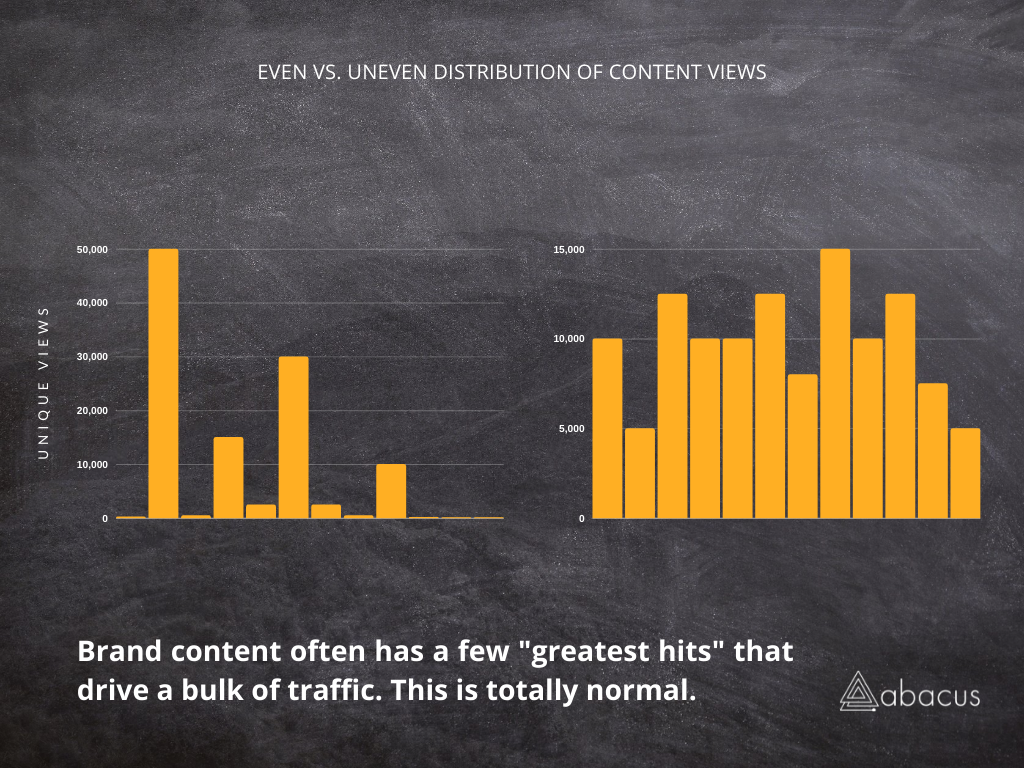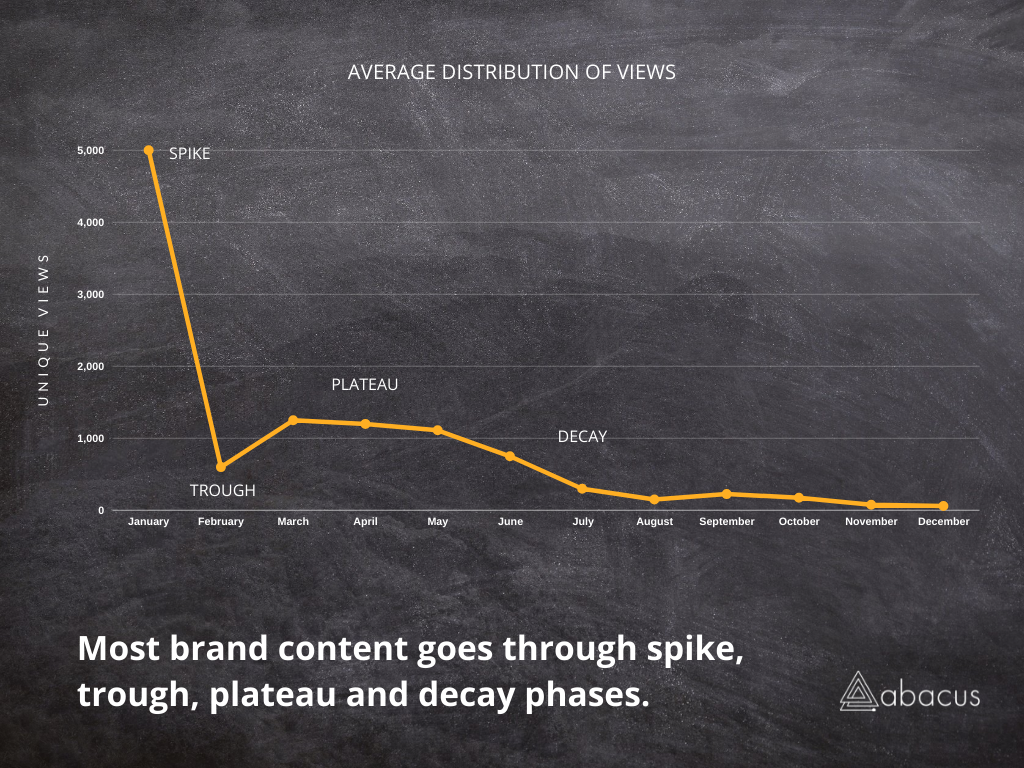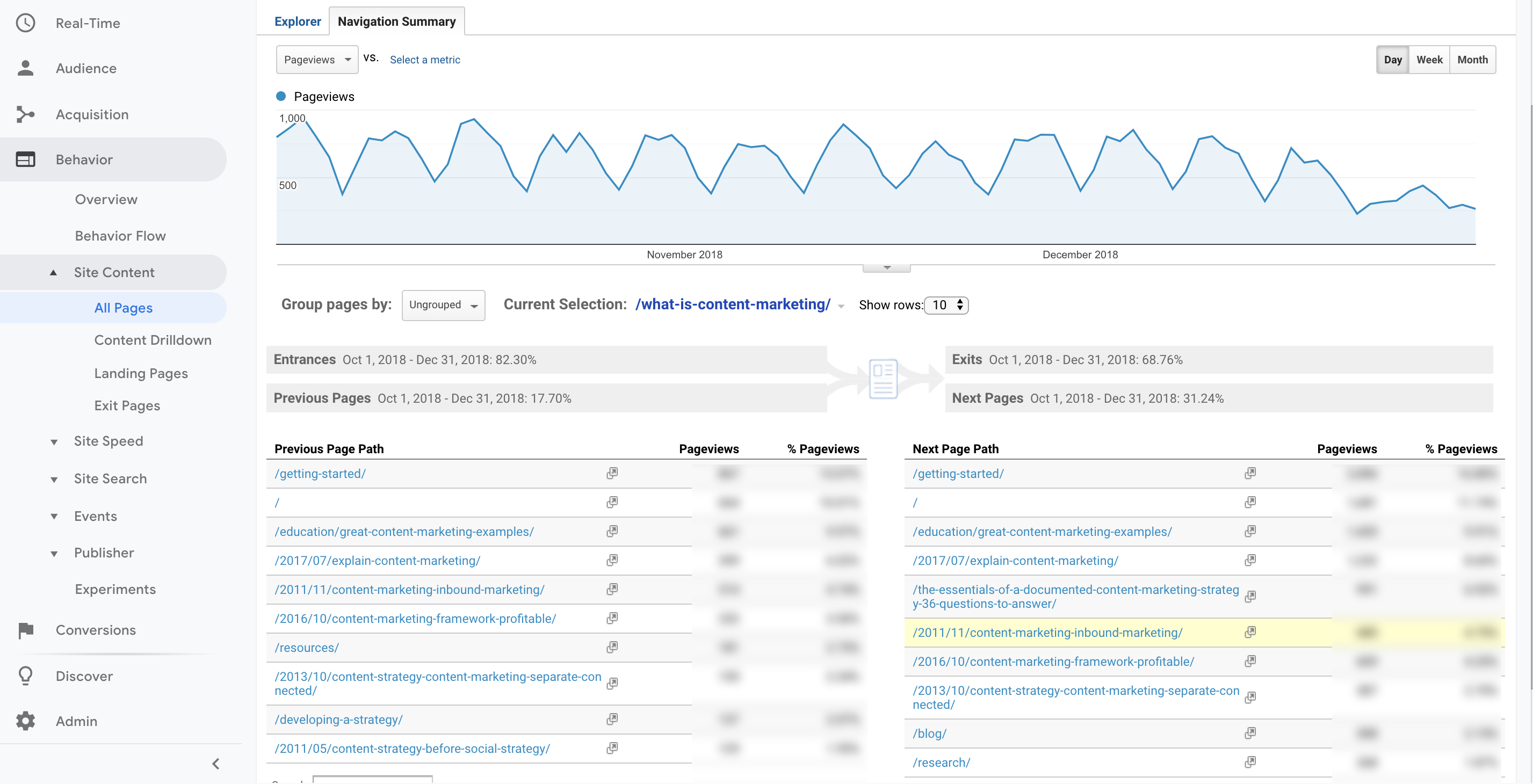Content marketing is one of the best investments a brand can make.
You’ve all heard this one: create an article or video once, post, and let the long-tail leads come rolling in year over year.
“We still get leads from a 2011 post!” marketers will shout from the rooftops.
Content marketing is everywhere, and for good reason. Unlike social, content marketing actually gets more valuable the longer it’s around.
But here’s the catch: that’s only to a point.
Like all things, user traffic to older content naturally grows cold.
Without a solid content marketing strategy in place, early wins soon fade away. To make things worse, the more content you create, the harder it is to manage the existing content you’ve already invested in.
So how, as brands, can we keep our traffic flowing without losing focus?
Simple: You need a content audit.
What Is A Content Audit?
A content audit is not a template or a magical score, it’s a continual process for evaluating (and re-evaluating, and re-evaluating, and…you get the idea) the value of your content.
It answers a critical question: Is this content marketing strategy really working for me?
A content audit will help you to do the following:
-
- Put your current content to work: While it’s the newest content that gets all the love from creators, a content marketing audit can easily identify how to improve and update current content to drive continued value. Who doesn’t love increasing ROI?
- Discover what content is working. A blog or YouTube channel that has 100,000 views and 20 videos will rarely, if ever, see a distribution of 5000 views on each video. Every site or channel has outliers that generate a bulk of their traffic (see the graphic below). A properly performed content audit will help you find these winners and use them as a guide to creating new content going forward. Similarly, it will identify the stinkers, and let you drop dead weight and topics that aren’t connecting with your audience.
- Match your channels to your marketing goals. A content audit can help identify “gaps” in your current use of content. When paired with a content marketing matrix, this can quickly and accurately identify gaps in your content strategy you can immediately move to fill.
- Connect the dots: linking content and improving discovery. There’s more to structuring a website than URLs and SEO plugins: a content audit performed by real live human beings can create a better editorial structure to your content: linked articles, playlists, cards on youtube video to learn more, there’s a lot you can do to keep users engaged, educated and moving further into your funnel.
A well executed content audit will give more than a faceless dump of Google Analytics data or bounce rates: it’s an attempt to deconstruct the “DNA” of your best content and clone those traits (topics, structure or tone) into your new content.

When do I need a content audit?
You can’t audit what you don’t have, so for a proper content audit we recommend starting around the 40-50 post mark. If your blog or channel has that much content, you should have already found a consistency (or cadence in marketing speak) that works and you’re producing on a schedule that’s roughly weekly. And that’s great: producing consistent content is the #1 hurdle content marketers have, so if you’re reading this far you can give yourself a high five.
But if you’ve produced a year of content and are reading this article, you’ve identified one of two big problems that need fixing through a content audit:
- The content strategy just isn’t working. Pretty simple: you’re not moving the needle. You’re trying everything to see if anything sticks and it hasn’t, or, you’ve tried to replicate a winner and it’s not reaching the same level of success and you don’t know why. This is much more common for marketers than you think!
- The content strategy is kind of working. . .but it’s kind of a mess. You’ve got a blog with hundreds of posts, or a YouTube channel with hundreds of videos, and some of it has stuck gold, but there’s a huge amount of dead weight that’s actually hurting your results, or your small team can’t manage to keep your content matrix properly working: there’s just too much to focus on the good from the, well, not so good.
Congratulations: If you feel like your content is stuck in either of these two ruts, your brand could benefit from performing a content audit.
Common triggers for a content audit:
- Your traffic has plateaued (or is declining!)
- Your page rank or SEO score has suddenly changed
- Old content is out of date
- You don’t even know how much content you have!
- Leadership has questions you cant answer about performance
- There’s too much content to manage for you or your team
If any of these sound familiar, then you’re in the right place.
A Content Audit is not an SEO Audit…or a creative audit
Yes, the relationship between SEO audits, creative audits and content audits is similar, but at their core, quite different:
- A content audit is designed to look at the whole of your content marketing. While topics, keywords and structure do intersect with SEO, a content audit also takes into account creative decisions like tone, imagery, personality and purpose. It is a complete picture of your marketing.
- A creative audit looks only at the visual, audio and text that displays your message and it’s impact. Creative audits will keep your brand’s buyers, style guide, and goals in mind while judging response to, and impression of the ads, posts and emails that your brand is producing. This does not take into account any technical aspects of performance like delivery times, nor does it take into account any goals for the content: only the presentation.
- An SEO audit is useful for improving your website’s search performance or fixing technical SEO problems but leaves many crucial elements of content performance unexplored.
How to Do a Content Audit (in 4 steps)
Like most other strategic audits, a content audit starts and ends with a list.
A big list.
Like, a really big list.
Using any tool you like, all your posts or videos go into a list or table with keywords, conversion rates, views, dates of publication, and most importantly, your top-level business goals, or verticals, you’re trying to engage.
Simply starting this process can be daunting, even a few years into a role as a marketer you can feel like it’s back to your first day with the overwhelming amount of cataloguing and qualifying you’re trying to do. Even deciding your “best” content can be difficult: how many times did the buyers return after before conversion? Does an article with 100k views and 10 conversions at a lower LTV than my niche article with a 1 huge win of a client count as good or bad?
Here’s our first secret to share: The trick to a proper content audit isn’t to collect infinite data to try and identify any and all factors for performance, it is to actually narrow the scope’s focus to be highly effective: start with a well defined goal and see if your articles or videos are furthering that by any metric you see fit: sales, shares, time on page or anything else that matters to your strategy.
1. Identify Your Main Area of Focus
This first step, narrowing the scope of your content audit, feels like you’re going in the wrong direction.
However, by narrowing the focus of your audit to meeting a few key business goals, it becomes much easier to identify what “DNA” is in each piece of content that’s getting across your (hopefully) well-defined finish line.
If you’re reading this, you’ve either found our guide by searching for “content audit” or by seeing a post that set off your marketing radar: “this is a problem I need to fix” you said to yourself.
And here’s probably why:
- Your overall traffic is declining month-over-month, and you don’t know why.
- There’s way, way too much content, and you need to better focus your labour
- You suspect technical problems hurt the SEO performance of your content.
- Your business goals are not being supported by your content, even though it’s popular with an audience

Identifying any of these problems is a great way to provide a focal point to your content audit: since each problem is unique to the other, different data will be required to find a solution and guide your content marketing strategy.
If you thought that the content audit would help expose what’s working for you and this seems backwards, don’t worry. Even a simple hunch that, say, articles to do with holidays are performing better is enough to get started.
2. Choose Key Data Points
Unfortunately most of the “how to do a content audit” posts out there recommend collecting every number under the sun but too much data can overwhelm and make it harder to reveal the “DNA” hidden within.
Yes: There are a few standard data points that are almost always useful, like views and conversions and revenue.
These are the obvious ones.
Of course your views, customers and cash-flow should trend upward.
However, beyond those, it’s better to select any further data points with care, as not to obscure the focus of your content audit.
For example:
- If overall organic traffic is declining, article traffic and keyword rankings provide a useful starting point.
- If you have too much content to manage, article traffic and conversion data will help you identify articles that can be “dropped.”
- If you’re worried about SEO performance, Google’s Core Web Vitals and tools like SEMRush can help immensely to identify problems
| Metric / Data Point | Example | Will help you understand… |
| Traffic | Pageviews Sessions |
Which articles or videos generate the most traffic to your site |
| Sources | Organic Search Direct / Referral |
Where your traffic is coming from |
| Conversions | Channel subscribers Free trial sign-ups Sales |
What pages, articles or videos are driving your goals |
| Content type | How-to’s Thought leadership Sales enablement |
How much of each type of content are you publishing |
| Social media performance | Social shares Likes |
What social channels are driving your viewers |
| Sitemap | Average number of linking pages Most and least linked pages |
How people are entering and exploring your site or channel |
| Engagement metrics | Time on page Bounce rate |
How your audience is engaging with your content… and for how long |
| Keyword rankings | Current keyword rankings Historical keyword rankings Total keyword rankings |
How your content is ranking for search terms and keywords |
| External linking structure | Backlinks Referring domains Domain authority |
How effective your blog content is in capturing traffic from other sites |
| On-page SEO | Metadata (meta descriptions, etc.) Header and page title tags URL slug |
How easily Google and other search engines can index your site or channel
|
There’s one crucial data point missing from this list, and that’s because it can’t be quantified by Google Analytics: the experience of your content. Data-heavy audits can make it easy to overlook important qualitative hallmarks of quality, while creative only audits can lose sight of discover-ability or delivery problems:
- Are your articles difficult to read because of bad formatting, run on sentences or busy design?
- Are your videos paced properly to convey a story or reward the viewers interest?
- What can you show with a graphic instead of a wall of text, or someone just talking to a camera?
- How does your content speak through your brand?
- Or most important: are you boring your audience?
Each of these qualitative data points can have a huge impact on content performance, but they won’t show up in a generic auditing spreadsheet.
This is where the critical thinking of a content audit comes in: is this truly the best content experience for your audience? Can you test against two styles of article or video? Can you poll your audience to gauge their response directly?
Quality, while seemingly ephemeral, has a massive impact on the performance of your content strategy.

3. Choose the right content audit tools
Most first-time content audits can be performed with the following:
A content analytic tool
A website crawler
A keyword research tool.
A Spreadsheet.
That’s it!
Everyone should be familiar with basic analytic tools: Google Analytics, Ads Manager etc. From these tools you can identify your key metrics (views, conversions, etc.) and export them to a spreadsheet.
Beyond that, other more specialized tools can provide additional context and data, ranging from paid tools like SEMRush to free tools from your web-host or other providers.
| Tool | Type | Helps collect… |
| Google Analytics | Content analytics | Traffic Traffic source Conversions Engagement metrics |
| Google Search Console | Content analytics | Keyword rankings Core Web Vitals |
| Lighthouse | Content analytics | Core Web Vitals |
| Octoparse | Website crawler | All article URLs Internal links On-page SEO |
| SEMrush | Keyword research | Keyword rankings Competitor content performanceOn-page SEO |
But be wary: the more tools you add to the audit process the more data you may uncover, but at the cost of overwhelming yourself with too much information. By keeping the process lean and iterative (remember, this is an ongoing audit) you can add data at a manageable rate and scale accordingly.
4. Use Your Data to Make Moves
Metrics are just numbers— it’s how you use them that gives them value, showing how to repeat the steps needed to make them move.
Like cooking a complex recipe, tackle your content audit in concrete steps:
For every metric you want to include, review the following:
- Your historical performance. Compare your content to it’s last period: is their growth or decline? What metrics like keyword ranking or referring sites / accounts may be affected by this?
- Compare to industry benchmarks. How does your content, and performance, compare to others in your industry? Even with steady growth you could be left in the dust by your competitors. What benchmarks can you compare?
- Look for outliers. Which moments or metrics stand out, for good or bad. Unexplained spikes can also help expose outliers and dramatically change your strategy once you learn why.
If your content audit is streamlined, researched and pointed towards a concrete business goal, you’re in good shape. Here’s an example of how a goal (better discovery) can become actionable via an audit.
- Problem: Website has low domain authority.
- Data: The number of backlinks per article, and their content type.
- Analysis: Our SEO content generates almost no backlinks; our thought leadership content generates more of our backlinks.
- Strategy: Shift focus for new content away from SEO and toward thought leadership; refresh and re-promote old SEO content to generate new backlinks.
Below are some of the most common recommendations made in content audits.
| Recommendation | Description | |
| Refresh content | Use traffic and conversion data to find articles suffering from traffic decay that need updating. | |
| Prune | “Drop” content that’s no longer performing | |
| Build content hubs | Use internal linking structure and keyword data to identify “de facto” hubs and spokes and recommend new hubs and spokes for core keywords. | |
| Identify high-leverage keyword opportunities | Create content to target low-hanging keyword opportunities (e.g., keyword gaps between you and your competitors). | |
| Identify missing content pillars | Choose a new content pillar to add to your strategy (e.g., create thought leadership content to improve social distribution and generate backlinks). |
Growth from Old Content
And finally, the most important part of benefit of performing a content audit: growth from old content (and the resultant ROI rocket-ship).
Most content marketers (myself included) spend the majority of their effort on upcoming content. And yes, this content audit will help your brand find where to go to keep growing.
However we’re sitting on nearly two decades (or more, depending on who you ask) of content marketing, a rich, fertile soil from which to grow fresh new revenue. Small changes like updating dead links, changing headers, adding new research or removing outdated content can re-invigorate your engagement and generate thousands of new customers.
Larger changes like creating “best-of” content, or compiling past articles into long-form editorials, can re-purpose old content with a new strategy to help accelerate it’s impact.
What’s next?
Still lost for clarity on your content marketing strategy? You can contact us to grow your brand with better content marketing, better creative and better strategy. Let’s get started!
Looking for more brand building content? Check out these other great articles:
E-Commerce: Product Pages That Work (With 5 Great Examples)
Content Marketing: Building A Content Marketing Matrix In 8 Easy Steps
Advertising: Instagram Reels For Advertisers: Essential 2021 Update
The Future: You Wont Need 30 Second Ads Soon – Here’s Why